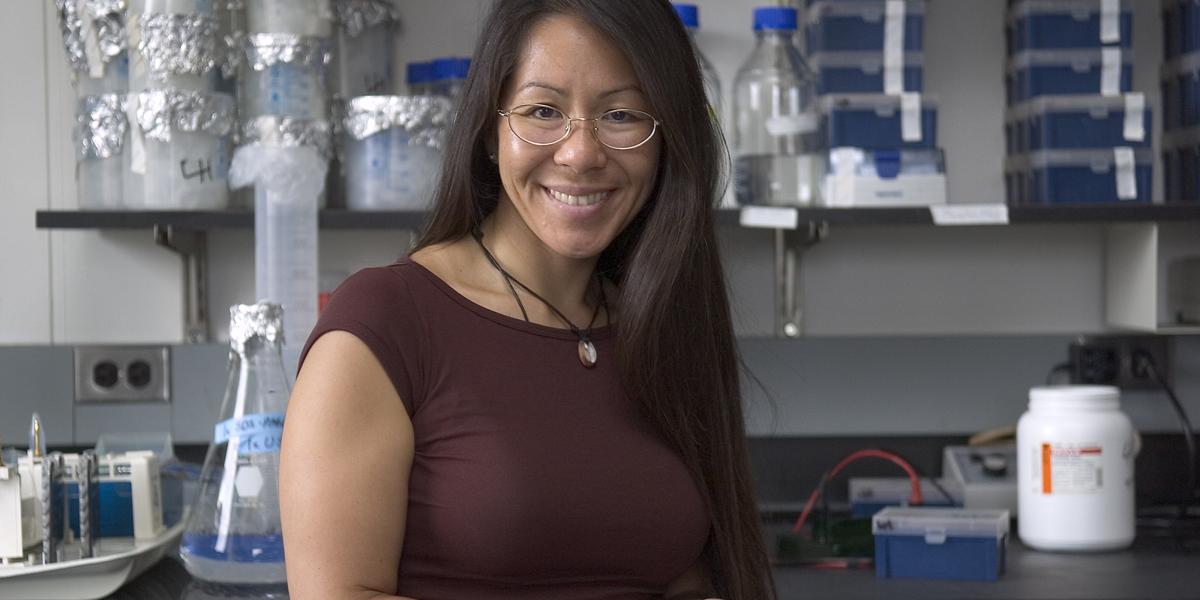Enemy Within
Sometimes, processes in the human body work too well.
Breaking Cancer’s DNA Repair Machine
DNA is your body’s blueprint and the very stuff that makes you up. And it is constantly breaking down. Every day, every cell in your body is assaulted by toxins, cigarette smoke and ultraviolet light. These are just a few of the things that damage DNA.
Luckily, the human body knows how to fix it.
One way is a mechanism called non-homologous end-joining (NHEJ). The DNA molecule is shaped like a twisted ladder: two parallel, curving strands of the acid joined by rungs of nitrogen bases. When both strands of DNA break, NHEJ detects the exposed DNA ends and rejoins them. But how?
That’s what Leslyn Hanakahi wants to know. Hanakahi, PhD, assistant professor of Biochemistry and Molecular Biology, thinks part of the answer lies in inositol hexakisphosphate (IP6). Hanakahi discovered the chemical in 2000 while doing her postdoctoral work at Cancer Research UK. “We came across IP6 with a huge dose of luck,” she says. “I was looking for a protein and came up with a chemical.” She discovered that, in a test tube, IP6 stimulated the NHEJ pathway.
That’s a good thing—when normal cells are being repaired. But what about when NHEJ puts damaged cancer cells back in business? Or when it competes with cancer treatment?
NHEJ is especially troublesome during radiation therapy. One way that radiation destroys cancer cells is by creating double-strand breaks in their DNA. But then NHEJ comes along and repairs the DNA, allowing cancer cells to grow and divide and increase tumor mass.
Hanakahi hopes that her lab can devise therapies to stop NHEJ in tumor cells. She is working with a drug discovery group at Cancer Research UK to find compounds that inhibit interactions between IP6 and the NHEJ apparatus, and to discover how they could work in therapy. “If we know how the machine works, we can break it,” she says.
And if the machine is broken, radiation can do its job more effectively —in smaller doses. Reducing the level of radiation should alleviate some of the treatment’s side effects. “If we can cut down on the [radiation] therapy,” Hanakahi says, “we can improve the quality of life for cancer patients.”
A Novel Approach to Preventing Parkinson’s
Something’s wrong. Deep in the brain, in a region known as the substantia nigra, neurons are dying. Their deaths mean the brain has less dopamine, an essential brain chemical. Without it, nerve cells in another part of the brain (the caudate/putamen) don’t function properly. The result: A person suffers tremors, shaking and physical rigidity—and eventually death. It’s known as Parkinson’s disease, and it affects more than 1 million people in America alone.
Molecular toxicologist Tomás Guilarte and chemoprevention expert Thomas Kensler are trying to set things right. They are targeting free radicals, the incomplete oxygen molecules that serve as the human body’s hit men. Free radicals normally kill bacteria—a good thing. But unchecked, they also act like rampaging vigilantes, damaging neurons in the substantia nigra. Free radicals do this because they are not only a wild bunch but a lonely hearts club as well.
Lacking an electron, they constantly seek to replace it by reacting with other molecules in a process called oxidation. It’s this process that damages neurons. People with Parkinson’s typically lack sufficient antioxidants to fight off oxidation.
Guilarte, PhD ’80, and Kensler, PhD, both Environmental Health Sciences professors, are embarking on a new project to determine whether increasing levels of antioxidative enzymes in the brains of mice offers protection against a chemically induced form of Parkinsonism. The trick is to get the brain to increase the levels of antioxidative enzymes like glutathione S-transferase.
To do this, the researchers will give the mice sulforaphane, a chemical found naturally in cruciferous vegetables like broccoli. Sulforaphane spurs the production of enzymes that eliminate free radicals, thus protecting the dopamine-producing neurons. To measure their success, the researchers and Martin Pomper, associate professor of Radiology at the School of Medicine, are using positron emission tomography (PET) to monitor the loss of dopamine-creating neurons in animals.
Guilarte and Kensler hope their approach will offer an alternative to the invasive Parkinson’s treatments currently used (some of which transplant dopamine-producing cells into the brain). “Our approach is a noninvasive way: by taking a pill” or eating a sulforaphane-rich food like broccoli, says Guilarte. “It’s a potential novel approach to preventing or arresting Parkinson’s.”
When Copper Delivery Goes Awry
Working with yeast cells some years ago, Valeria Culotta made a far-reaching discovery: An enzyme inside every cell, superoxide dismutase (SOD), which is vital for neutralizing damaging free radicals, needs copper ions to function properly.
Now the professor of Environmental Health Sciences has taken her copper research an important step further, in hopes of shedding light on the origins of amyotrophic lateral sclerosis (ALS), or Lou Gehrig’s disease.
Culotta, PhD, believes that ALS can result when copper interacts improperly with SOD. The result: The SOD enzyme becomes damaged and begins to pile up, and this accumulation of the damaged enzyme can kill motor neurons until eventually the body becomes paralyzed.
Culotta and her team have determined that human SOD can get copper by either of two routes, both of which Culotta and her team discovered. The first, dubbed copper chaperones (CCS), delivers copper molecules into the active site of the SOD enzyme correctly, the researchers believe. But with the second route, known as the glutathione reaction, the copper may be joined to SOD at the wrong angle, and this may play an important role in triggering ALS.
Culotta and company have pinpointed the amino acid sequence they believe is responsible for determining which pathway—the helpful CCS or the damaging glutathione—will be favored. They are working now to see if the glutathione pathway can be blocked.
“If the glutathione pathway indeed turns out to be the culprit,” says Culotta, “we may advance the search for a treatment for ALS.”
